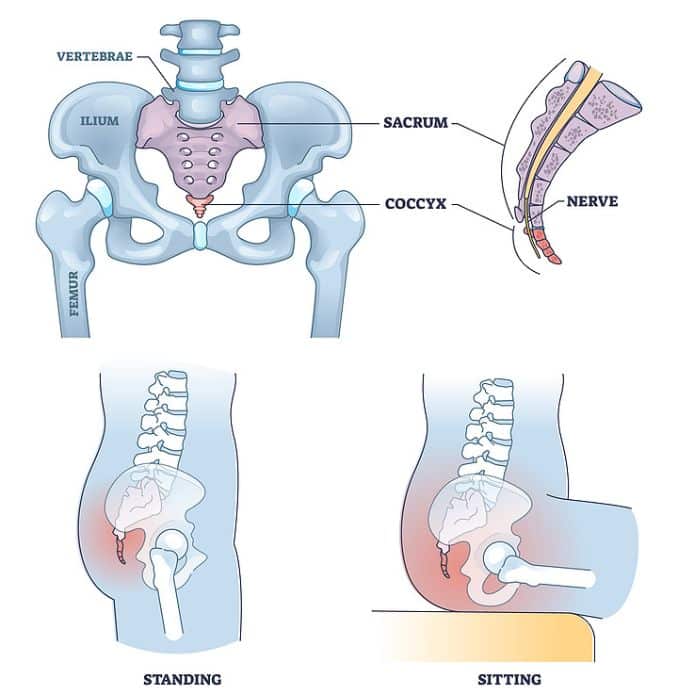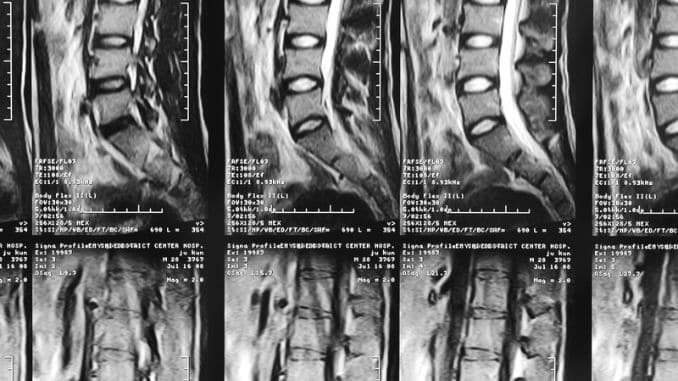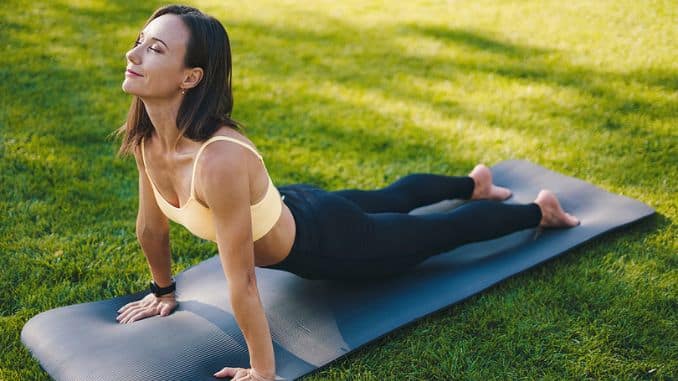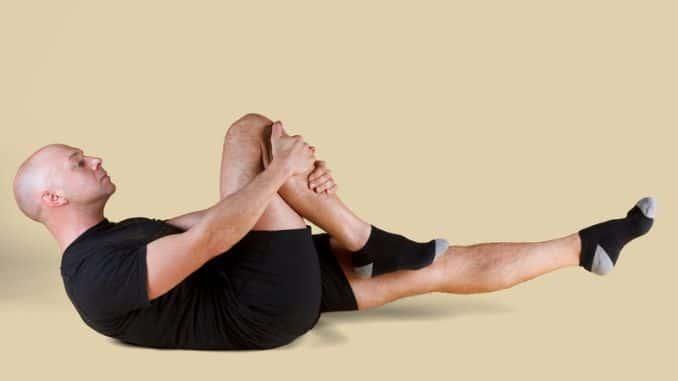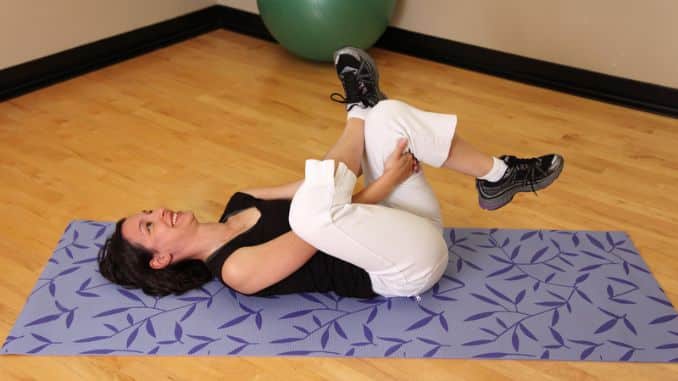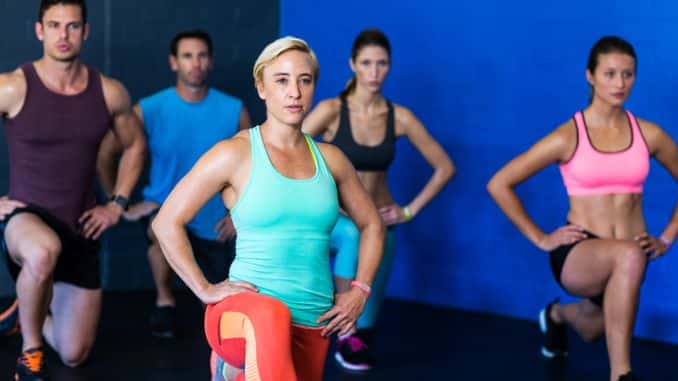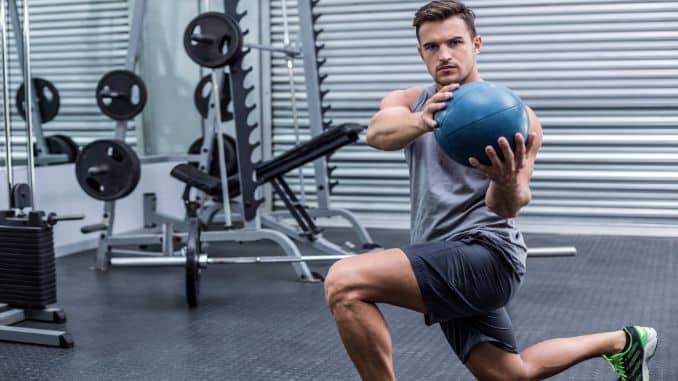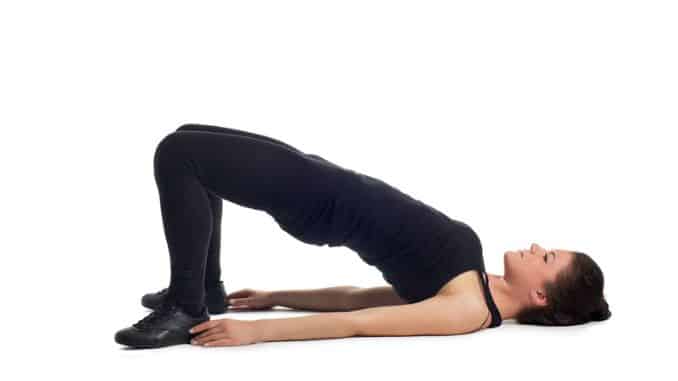
Do you experience Pain in your tailbone, especially when sitting? Does the Pain lessen when you are walking? Then you might be experiencing coccydynia or commonly known as tailbone pain. This condition may be bearable. However, it makes an everyday activity uncomfortable. You should do some exercise to relieve tailbone pain.
The Coccyx
The coccyx is a triangular-shaped bone located at the bottom of the spinal column, just below the sacrum. The coccyx resembles a vestigial tail, thus the common name, tailbone.
This bone is damaged or even fractured. This causes Pain in your tailbone, worsening when sitting and improving when walking. Using safe remedies at home and lifestyle modification may help manage this condition.
Usually, the coccyx has three to five bones fused or semi-fused together, depending on the person’s development. Due to the fusion of the bones, it has limited movement of the bones permitted by fibrous joints and ligaments.
The coccyx joins the sacrum by the sacrococcygeal joints. However, it has a role in the pelvis. It distributes the weight to provide balance and stability. When sitting, it supports the individual in a three-part support system.
The lateral edges of the coccyx serve as a site for the insertion of the coccygeal muscles, the sacrospinous ligament, the sacrotuberous ligament, and the fibers of the gluteus maximus muscle. Meanwhile, the iliococcygeus muscle tendon inserts onto the tip of the coccyx. These different structures help and support the pelvic floor and contribute to defecation.
How does Coccydynia occur?
Trauma is the most common cause of this condition, such as falling directly on the coccyx or during childbirth. Coccyx pathological instabilities are believed to be the root of inflammation and Pain.
Obesity can also be a cause of coccydynia. The coccyx tends to stick out posteriorly when overweight people sit down due to a lack of side pelvic rotation. When sitting, pressure builds up in the pelvis, causing the coccyx to subluxate.
The coccygeal configuration types influence the pain level felt by an individual.
- Type I. Coccyx is slightly curving forward, with its crown directed downward and extremely.
- Type II. Apparent forward curvature of the coccyx and apex extends straight forward
- Type III. The coccyx is more angulated forward
- Type IV. The coccyx is subluxated.
From left to right, Type 1, Type 2, Type 3, and Type 4.
What are the symptoms of Coccydynia?
The following symptoms characterize Coccydynia:
- Localized pain and tenderness – Pain localizing in the area of the tailbone. No pain is felt in the pelvis or on the lower leg. Pain felt describes as ache and soreness and can be mild or severe. There was constant tightness, Pain, and discomfort applying the pressure around the tailbone area.
- Worsen Pain when sitting – When sitting on a hard surface without a soft cushion or when a person leans backward in a sitting position, it puts extra pressure on the coccyx causing Pain to worsen or increase.
- Severe Pain when standing up from sitting – The movement from sitting to standing where the rotation of the pelvic bones and muscle movements that assist this rotation is painful.
Diagnosis
Coccydynia is often diagnosed through a thorough medical and physical examination. The medical examination includes the current symptoms, how it was acquired or developed, lifestyle or if they had recent injuries, and more.
A physical examination will be conducted after the medical history is taken. It includes palpation, an Intrarectal exam, and manipulation. During palpation, the doctor will palpate around the coccyx area to look for swelling and tenderness or even coccygeal spicules (bone spurs), cysts, or tumors. During intrarectal examination and manipulation, the doctor will manually try to manipulate the coccyx through the rectum to assess hypo or hypermobility of the sacrococcygeal joint.
In some cases, although not necessary, diagnostic procedures or tests can do. It includes dynamic X-ray imaging tests, Coccygeal discogram, computerized tomography, and Magnetic Resonance Imaging scans.
In a dynamic x-ray, two images will be produced. One is when the patient is in a sitting position, and another is when the patient is in a standing position. The doctor will then compare the two images and measure the angle of pelvic rotation and the coccyx’s position. Indicating the condition is when the measurements are outside the normal range between 5 and 25 degrees.
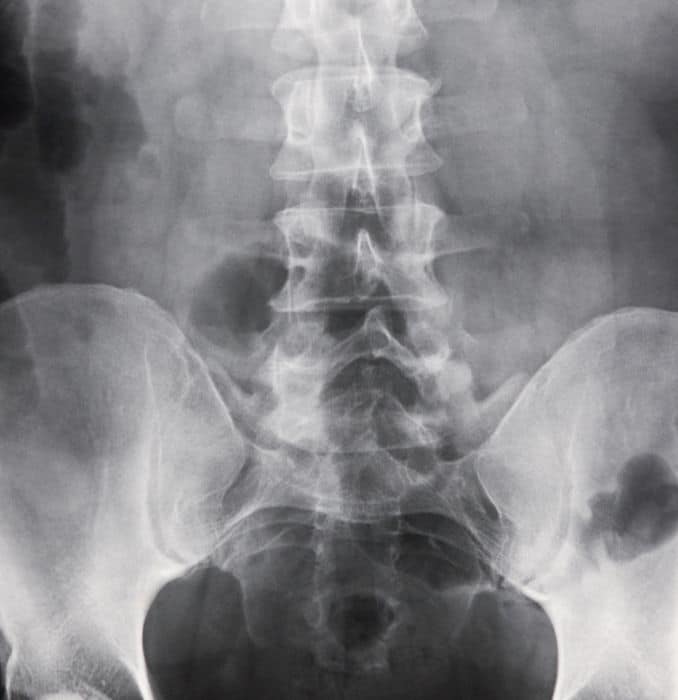 |
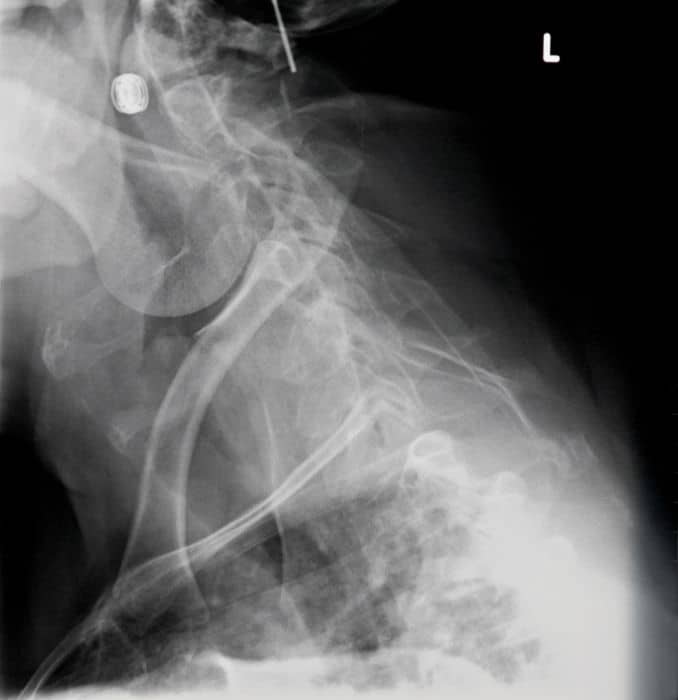 |
In a Coccygeal discogram, injection of local anesthesia on the sacrococcygeal region, either on the intervertebral joint or disc, is done. It is to determine the exact location where the Pain is coming from.
In Computerized Tomography (CT) and Magnetic Resonance Imaging (MRI), an image of the coccyx is produced to diagnose a fracture, tumor, or abnormal mobility of the sacrococcygeal joint.
In rare cases, a routine blood test is done to rule out infection or tumor.
Treatment
Most cases of coccydynia can be successfully treated with nonsurgical treatments and lifestyle modification. Treatments include:
- Non-steroidal anti-inflammatory drugs (NSAIDs) – Ibuprofen (Advil), naproxen (Aleve), or COX-2 inhibitors (Celebrex) are examples of NSAIDs that can help reduce the inflammation and Pain around the coccyx area.
- Cold Therapy/Ice pack – Applying cold therapy or an ice pack to the area for the first 24-48 hrs of the injury can help reduce inflammation and Pain.
- Heat Therapy/ Heat pads – Applying heat therapy or heat pads to the area can help reduce muscle spasms. You can also use a hot water bottle, chemical heat pack, long-lasting adhesive heat strip, or hot bath.
- Lifestyle modification – Modifications to activities may help reduce Pain, like using pillows, soft cushions such as U- or V-shaped pillows, and wedge-shaped pads with a cutout or hole where the tailbone is when sitting. It is to lessen the pressure on the coccyx.
- Dietary changes – Increased fiber and water intake are recommended if the Pain is increased during bowel movements, constipation, and stool softeners.
- Injection – Lidocaine, a numbing agent, and steroid are injected to lessen inflammation and Pain in the coccyx area. The injection may last for a week up to several years, and they may receive up to 3 injections in a year.
- Manual Manipulation – Manual manipulation of the coccyx will relieve Pain. It involves adjusting the sacrum and coccyx joint to reduce Pain.
- Massage – Spasms of the pelvic floor muscles can be massaged to relieve Pain. This causes added strain on the ligaments and sacrococcygeal joint, which limits mobility, thus pulling the coccyx.
- Stretching – Gentle stretches for the ligaments attached to the coccyx can help reduce muscle spasms.
If these nonsurgical treatments are ineffective, This includes surgical removal of all or a portion of the coccyx or coccygectomy.
Exercises
1. Cobra
This stretch or exercise to relieve tailbone pain aims to open the chest and keep the back supple and healthy while regenerating the torso muscles and relieving lower back pain.
In a prone (faced down) lying down position, place the elbows on the floor under the shoulders with the hands forward. Stretch and lift the chest to the sky while extending the elbows and straightening the arms. Keep your hips in contact with the floor. Keep lifting out of the lower back. Squeeze the shoulder blades together. Squeeze the glutes. Breathe deeply as you hold this stretch for one minute. Look between your eyebrows.
If you do not have the flexibility to straighten the arms, lift as high as you can with the elbows bent.
2. Single Leg Knee Hug
Lie down on your back, then bend the right knee towards your chest until you feel a stretch. Hold for 30 seconds, then go back to the resting position. Repeat on the right knee. Do this exercise to relieve tailbone pain for 3 repetitions, 1-2 sets.
This stretches the piriformis and the iliopsoas muscles.
3. Figure 4 Stretch
Lie down on your back. Bend your knees towards your chest with your foot flat on the floor. Bend your right leg, put your right ankle across the left knee, and then hold your right thigh. Slowly pull it towards you until you feel a stretch. Hold in for 30 seconds. Do this exercise to relieve tailbone pain for 3 repetitions, 1-2 sets.
This stretches the piriformis as well as the gluteal muscles.
4. Cat/Cow Stretch
This exercise aims to limber and stretch the back and neck muscles, stimulate spinal nerves, align the vertebrae, promote blood flow, and relieve back and neck pain.
Place the body in a prone (face-down) table-top position with the hands directly under the shoulders and the knees under the hips. Round your back up to the sky (Cat), then arch your back with your head lifting (Cow). As the Cat stretch is performed, exhale. The Cow stretch is performed, inhale. Perform this exercise to relieve tailbone pain for one minute.
If the hand placement hurts the wrists, make the hands into fists to alleviate the Pain.
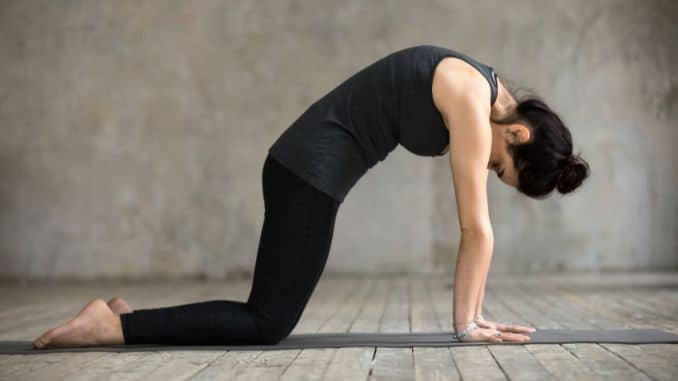 |
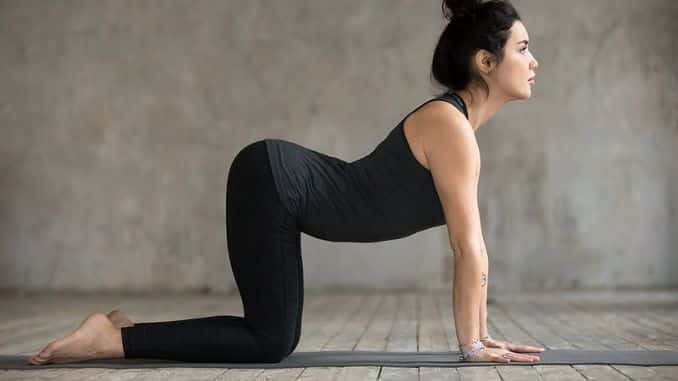 |
5. Kneeling hip flexor stretch
Kneel on the floor, and bend your right leg forward at a 90-degree angle with your foot flat. Put a towel under your left knee for comfort. Rest your hands on your hips for stability. Tilt your pelvis anteriorly and slightly lean forward. Hold in for 30 seconds. Do this for 3 repetitions, 1-2 sets.
This stretches the iliopsoas, which consist of the iliac and psoas muscles.
6. Kneel and Twist
Kneel on the floor, and bend your left leg forward at a 90-degree angle with your foot flat. Then raise your arms to shoulder height out to the side. Put a towel under your left knee for comfort.
Rotate your trunk toward the left side of the body and stop when the components are almost in line with the legs. Then slowly return to the resting position and do it on the right side. Do this for 7 repetitions, 1-2 sets.
This stretches the iliopsoas as well as improves mobility through the lower back.
7. Child’s Pose
Kneel on the floor while sitting on your heels. Then place your hands flat on the floor. Slowly slide your body forward until you fully extend your arm while keeping your head down. Bring the forehead to the floor. Hold in for 30 seconds. Do this for exercise to relieve tailbone pain for 3 repetitions, 1-2 sets.
8. Reverse Kegels
Reverse Kegels are the opposite of standard Kegels. This focus on releasing and relaxing the pelvic floor muscles. This also helps remove an overly flexed tailbone, hypo-mobile and painful. Traditional Kegels concentrate on contracting and releasing the pelvic region. Both types can help balance your pelvic floor.
You can exercise while sitting, standing, or lying down on your back with your knees bent.
Once you’re in position, breathe deeply and bring awareness to your pelvic floor. Feel your muscles relax and drop down as you inhale.
Find the position where you feel like sitting on your perineal tissue. This is the soft tissue between the anus and the scrotum in males or the anus and vagina in females.
Place your hands on your belly and focus on taking diaphragmatic or belly breaths where, on the inhale, your belly expands.
As your belly expands, think about relaxing and lengthening the perineal tissue into your chair, imagining a flower blooming.
Keep that relaxed on the exhale and imagine further lengthening on the next inhale.
With practice and improved body awareness, you should feel increased contact between your perineum and chair with a true reverse Kegel.
Hold the reverse Kegel for 5 seconds and then release simultaneously. Do two to three sets of 10 throughout the day. Once you master this, you can try holding and releasing for extended periods.
Make sure you’re breathing while doing these exercises. Living in your belly as you inhale (instead of only breathing into your chest) is essential. Keeping your stomach relaxed helps.
Things to remember:
- Avoid sitting in a poor slumped posture, such as sacral sitting. Sitting this way lessens coccyx bone motion and can reinforce poor alignment.
- Avoid sitting longer than 15 to 20 minutes if you have coccyx pain. Shift your body weight as needed to lessen the tailbone pain, and if necessary, sit on a unique pillow called a donut to relieve tailbone pain.
- Massage the pelvic floor muscles intra-vaginally or intra-rectally to release any tension/trigger points in the muscles that can keep the tailbone stuck, hypo-mobile, and in a sad state. See one of our pelvic floor therapists for proper instructions on this special massage.
- Avoid pushing with defecation and avoid constipation. Moving with bowel and bladder function can increase both coccyx and rectal Pain. See us, and we will show you how to relax your pelvic floor muscles for defecation.
Takeaway
Preventive measures may be taken, so you don’t acquire this condition. Here are some of the following:
- Use a Coccyx cushion – These can help reduce pressure on your tailbone when sitting.
- Avoid prolonged sitting if possible – Regularly walk or stand up from sitting to avoid too much pressure on the tailbone.
- Avoid wearing tight jeans or trousers – It can put additional pressure on the tailbone.
Tailbone pain might be uncomfortable but is often temporary. Visit a doctor if symptoms become severe. Do the necessary management and treatment, and it will recover quickly.

